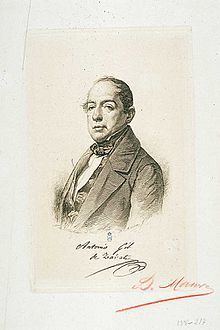Name Antonio y Role Dramatist | ||
 | ||
Parents Antonia de Aguirre i Murguia Books Charles the Second, the Bewitched Similar People Maria Luisa of Parma, Maria Christina of the Two S, Francis - Duke of Cadiz, Louis I of Spain, Infanta Luisa Fernanda | ||
Antonio Gil y Zárate (1 December 1793–1861) was a Spanish dramatist and pedagogue whose work is associated with Romanticism. He is known for his tragedy, Guzmán el Bueno. Drama en Cuatro Actos, set in the Middle Ages and exploring the life of a legendary hero of Spain. During his lifetime he enjoyed popularity for other works as well.
Contents
Early life and education
Antonio Gil y Zárate was born in El Escorial in 1793 to Bernardo Gil, an actor well known in Madrid, and Ántonia Zárate. His mother died when the boy was quite young, and his father married a "celebrated actress", Antera Baus, so Antonio grew up in the world of theatre in Madrid.

As a youth, Gil y Zárate was sent to France for several years for his studies; he also studied in Madrid, Spain, in the subjects of physics and mathematics. He spent another two years in France in studies, where he also enjoyed the latest works in French literature. After returning to Spain, initially Gil y Zárate entered Spanish politics, like other young men of his class, but he soon started writing dramas.
Literary career
Gil y Zárate wrote his first play, the comedy La Cómico-Manía, in 1816, and was given encouragement. During the mid-1820s he had to deal with censorship, particularly that religious censorship by the Catholic Church, and ran into opposition for his work. For a few years he supported himself by teaching French at a commercial school in Madrid, until the climate lightened.
His next works to be produced were Blanca de Borbón, produced in 1835, and Carlos II el Hechizado in 1837, which was highly popular. At the turn of the 20th century, the American scholar Sylvester Primer characterized this play as full of "irreligious and obscene sentimentalism," and Gil y Zárate tried to recall it.
The playwright's most productive period was in the 1830s and 1840s; while his plays during this period were extremely popular, these have not been considered of lasting value. His play, Guzmán el Bueno. Drama en Cuatro Actos, set in "medieval days of Spanish history," was considered to be his most substantial. It explored the life of a national hero of Spain, Alonso Pérez de Guzmán, who had been treated as a figure in the nation's plays and literature for some time.
Later life and legacy
Gil y Zárate died in Madrid. The mineral Zaratite was named after him.
